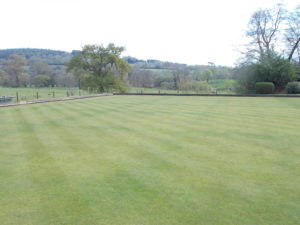
16th April 2020 -our first professional cut of the season- with straight lines
Our big challenge is to start with a damaged and worn green at the end of
September and to produce a green suitable for bowling for league and county
play by the beginning of May despite what the autumn and winter weather
and any turf disease has thrown at you. After this year’s rain and winds and
previous years “beast from the east” it is always something different.
This year brings a virus that has brought the whole world to a standstill with
nobody quite sure what the future brings but a future will come and we need
to be ready for it. I fully realise that there are much more important things that
preparing turf for sporting activities but in the context of the future enjoyment
and fitness of thousands of people it has a place in the life of many.
The challenge now then is to produce a surface for some unknown date in the
future whilst being aware of the financial constraints of many clubs and also
being aware of the governments social distancing rules. Much
advice/recommendations have been issued by golfing associations and I have
spoken to a groundsman at a cricket venue and of course I have been scouring
the UK for any information specific to bowling greens including Bowls England,
Bowls Scotland, Bowls Wales, Bowls Central, our fertiliser supplier, Alan Pearce
and others in the county. As with most expert opinion everyone is not in total
agreement for example for height of cut varies from 5.00mm to 12.00mm and
most figures in between.
Based on a full assessment of the advice, the budget available and the
personnel able to work either individually or in very small groups every
greenkeeper will have to make the best decisions for the health of the
members and the club.
